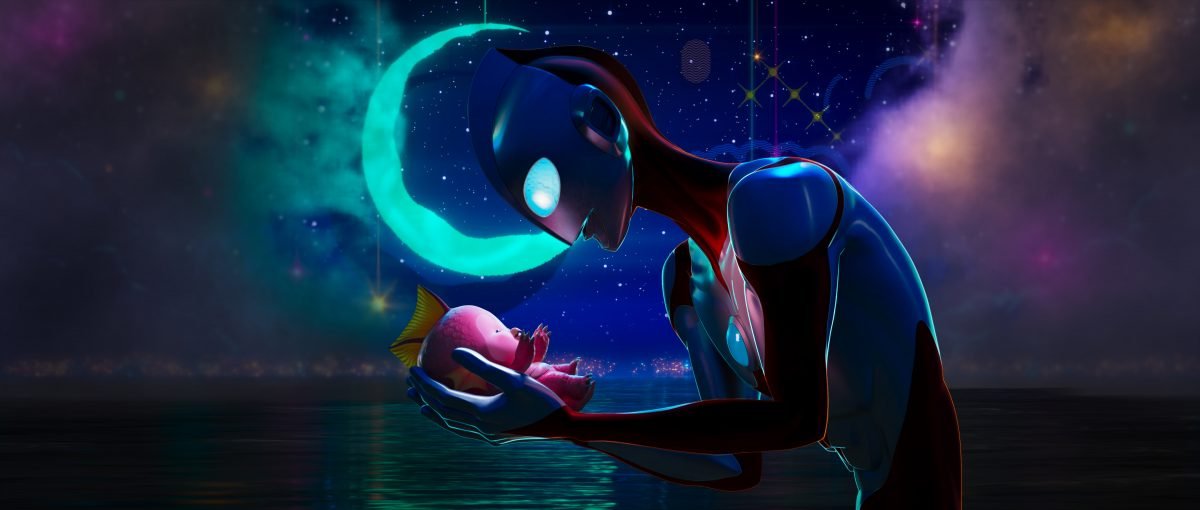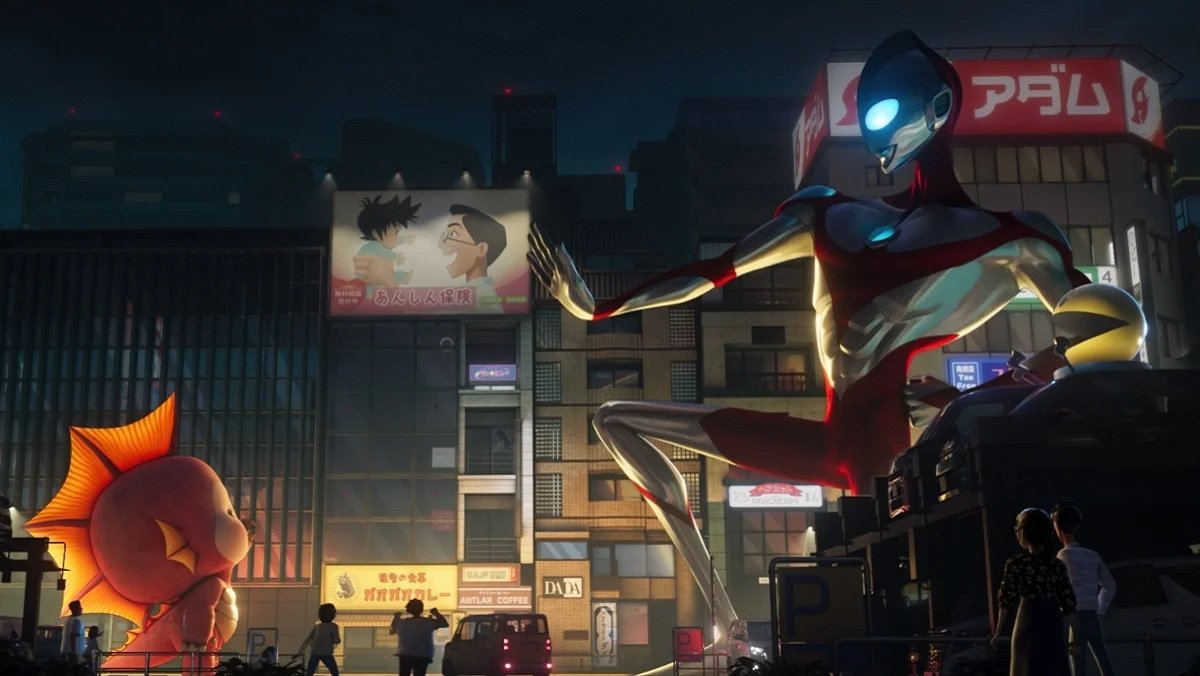Getting people I know to care about Ultraman, the iconic Japanese superhero series that began in 1966, was once a herculean task. I love it, and I want to share it with other people! But the language barrier is real. The success of Shin Ultraman has made it much easier, and now that Netflix is set to debut the English-language animated film Ultraman: Rising, it’s even more so! The film comes to us from the multi-talented writer-director Shannon Tindle (Kubo and the Two Strings). He, like me, is a huge Ultraman fan, but he never set out to make a film with the giant silver kaiju-fighter. It’s a fascinating story.
I got to speak to Tindle about creating his version of Ultraman universe tied to a brand new trailer. Check out the trailer, then read my interview below.
Nerdist: I know you had this idea for years and years and years. At what point did it become clear, oh, I could actually do this idea with Ultraman? How did that whole process even come about?
Tindle: I developed the idea at another studio. The film went into turnarounds. They were very gracious about me taking it out. And when I came over to Netflix to pitch it, I came into a room with Melissa Cobb and Greg Taylor and a lot of other folks. I didn’t know there were going to be that many folks in the room. And Armi Kubian, who had just gotten back from a trip to Japan, he was living in Singapore at the time, and he said, hey, I met with Tsuburaya Productions and… there had been all these rights issues for years with the characters, and they finally got it cleared up in 2018, just as I was leaving Sony.
They’re like, how would you like to make this an Ultraman movie? And I said, well, as long as I can make this story that I wanted to tell. Because I didn’t want to make a superhero story, I wanted to make a story about family and about conflicts between parents and children. If Tsuburaya supports that, then let’s do it. I’ve met with Tsuburaya and they could not have been more kind, and they’ve been so incredibly supportive from day one, and I’ve become friends with them and they said, yeah, we want to tell the same story that you want to, and we’d love for it to be an Ultraman story. So, that’s how it came about. I keep saying like fan fiction became reality.

Man, that’s such a great story. Once Tsuburaya was on board, and it was an Ultraman movie, you got to dig through their toy box, so to speak, with all those kaiju and amazing sound effects. What was the process like of deciding what of theirs would fit into your story?
Tindle: I created, as the original Kaiju, Gigantron, before it was Ultraman and there was no reason to change her. She served purposes of the story and I did the design, so I was like, hey, I’m happy with this design and let’s do this. But I’ll never forget, the first time that we visited them was in October of 2018. And it was crazy because we got on the plane, it was when the Dodgers had that insane six hour game.
I remember getting on the plane with Melissa Cobb, who was running the division at that time, and we were about to take off and the Dodgers won. So that was like, oh my gosh, there’s this team that we’re actually featuring in the story and they’ve just won, that’s cool, and now we’re going to Japan. So, I pitched the story to Tsukagoshi-san, who’s the chairman, and CEO [of Tsuburaya] and Minamitani-san, who is kind of head of global there, and Onda-san, who is one of the creative directors there, the whole team.
They let me go through the binders of all of the Tsuburaya stuff. And that’s not just Ultraman, it was like Redman and all these other really cool characters. And I was just freaking out kind of going through it. I’m like, oh my gosh, now I’m going to take the script and I’m going to get to incorporate Ultraman into it. But really the goal was, preserve the story because everybody responded to the story. Let’s just work the mythology into the story in a way that supports the story we’re already telling. So, if we’re going to have our version of the science team—it’s what you kind of need to do when you do an Ultraman series—can we approach it in a different way?
And my point of view is like, let’s show them in a different light. Let’s show what happens if they’ve been kind of twisted from their original goals. But we wanted to have little tips of the hat to that. So, the orange costumes that KDF wear in our movie are actually inspired by the SSSP costumes in the first series. So, those were the things that, there’s the gift wrapping that you want to put on it and the frosting, but it always has to be in support of story that you’re trying to tell.

But ultimately, I wanted to make the film for people who don’t know anything about Ultraman. I wanted to get them excited by it, and as anybody who’s watched the Ultra series knows, they evolve constantly. Every couple of years, it’s a new Ultraman. So, it’s one of those characters that, because that’s traditionally what it’s been, there’s no locked-in canon. I mean, there’s some things that are kind of like afterthoughts, I think, but it allows for evolution and reimagining.
Talk about serendipity, because you were meeting with them in 2018. During the pandemic, I feel like is when people in the West really started to get—that’s when all the Blu-rays started coming out and everything like that. So, the knowledge of Ultraman in the West has really grown in the time that you’ve been making the movie.
Tindle: So, that I would say in terms of Ultraman, there’s just a… one could say serendipitous, one could say, I just waited around long enough for this whole thing.
I guess that’s true.
Tindle: But yeah, it’s been pretty incredible in that regard, that there are all these things that seem to be happening at the moment, but I still think that, although there could be a lot more awareness. When we have our test screenings, there’s still people that don’t know who Ultraman is, and they may not ever watch a superhero film. Just something they’re not interested in but they’re engaging with the film on the level that I want them to engage on, and that’s the personal emotional level.
I hope it draws people to see the film. Because I want as many people to see it as possible. But more importantly, I want them to be like, that reminds me of the arguments I’ve had with my dad, that reminds me of my little girl or my little boy. Those are the things I really want them to connect with.

On the tip of parent-children dynamics, specifically about the main character Ken Sato, there’s sort of the inherited trauma of the character, but also the inherited responsibility. He doesn’t want to be Ultraman, he doesn’t want to be a father. He just kind of wants to be this brash baseball player. What was it about that specific story that you thought a superhero movie would suit?
Tindle: Well, again, it was more about what one experiences when they go from just having to worry about themselves to having to worry about your family. So, I don’t think anybody is prepared to be a parent. I certainly wasn’t. I wanted to be a parent, I just didn’t know what that meant until I fully committed to being a parent and I had a daughter. So, I used to be able to go to a movie anytime I wanted to. I could go to the comic shop anytime I wanted to. I could go hang with friends anytime I wanted to. But when I had a daughter, I had to understand that she needed me and needed to… what I started to do, is I just got up earlier and earlier and earlier, so I could do the things that I’d like to do.
I had to find balance. And that’s what the story is about. As a parent finding balance, you’ve got so many things going on, and to me, that makes it a compelling character regardless of genre, whether it’s a superhero film or not. I just wanted to make a relatable character. Because I thought there were a lot of people who might be parents and might be young parents who go, oh my gosh, I know exactly what that feels like.
When you’re exhausted after a long day, maybe you had a tough day—in this instance, Ken is humiliated at work, but he’s still got a child to deal with when he’s at home, and he has to be patient, and he has to reserve some time for her. There are times with my daughter where I would be playing with her on the floor and I would fall asleep playing with her. And I can still remember I’m just fading out of consciousness.
But that’s what it’s like to be a parent, is there’s this imbalance at first because you’ve got this new life that’s been brought into your life and disrupts it, and then how do you find a way to make it all work? And that seemed like a compelling story to me, and something that wasn’t typical of a superhero story. I mean, you could look at The Incredibles, which is a beautiful example of that. And of course, if you look at Spider-Verse now, those films work because people connect with them in an emotional way. Not because they’re superhero stories, not because it’s a Spider-Man story, but because they told compelling stories about interesting people. And so, I hope we did the same with this film.

Before I let you go, what is your favorite of the Ultraman special moves that you got to put into the film?
Tindle: I had to have Ultra Slash in there. I think that’s unique with the buzzsaw. It’s such a unique weapon that Ultraman uses, and it had to be in the movie, but I wanted it to be in defense of a Kaiju rather than to attack a Kaiju. So again, to turn those things on their heads, where Ultraman is using his powers to help a creature rather than to hurt it. So, Ultra Slash is a big one that’s up there. And then the other big one, I think fans are going to be happy.
Ultraman: Rising debuts on Netflix June 14
Kyle Anderson is the Senior Editor for Nerdist. He hosts the weekly pop culture deep-dive podcast Laser Focus. You can find his film and TV reviews here. Follow him on Instagram and Letterboxd.


